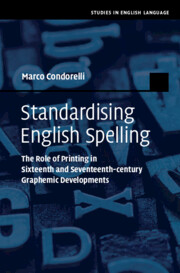 Standardising English Spelling
Standardising English Spelling Book contents
- Standardising English Spelling
- Studies in English Language
- Standardising English Spelling
- Copyright page
- Contents
- Figures
- Tables
- Acknowledgements
- Abbreviations
- Chapter 1 Introduction
- Part I Context
- Part II Empirical Method
- Part III Case Studies
- Chapter 7 The Standardisation of Positional Spellings
- Chapter 8 The Standardisation of i and y
- Chapter 9 The Standardisation of Etymological Spelling
- Chapter 10 The Standardisation of Vowel Diacritic Spelling
- Chapter 11 Conclusion
- Bibliography
- Index
Chapter 8 - The Standardisation of i and y
from Part III - Case Studies
Published online by Cambridge University Press: 31 March 2022
- Standardising English Spelling
- Studies in English Language
- Standardising English Spelling
- Copyright page
- Contents
- Figures
- Tables
- Acknowledgements
- Abbreviations
- Chapter 1 Introduction
- Part I Context
- Part II Empirical Method
- Part III Case Studies
- Chapter 7 The Standardisation of Positional Spellings
- Chapter 8 The Standardisation of i and y
- Chapter 9 The Standardisation of Etymological Spelling
- Chapter 10 The Standardisation of Vowel Diacritic Spelling
- Chapter 11 Conclusion
- Bibliography
- Index
Summary
Chapter 8 focuses on the graphemes underlying the letters i and y, and in particular <i> and <y> in word-initial, word-medial and word-final positions, as well as <ie> and <ye> word-finally. Between the sixteenth and the seventeenth centuries, i and y shifted from an early distribution principle to a new, modern standard, which generally resulted in the establishment of vocalic <i> word-initially and word-medially, as well as <y> for glides word-initially and for vowels word-finally. The analysis establishes the presence of a quantitative shift in the wholesale uses of <i> and <y> between the sixteenth and the seventeenth centuries, and provides a precise chronology for the standardisation of word-initial, word-medial and word-final graphemic changes in i and y. While it is true that their modern standardisation occurred rather gradually between the 1540s and the 1580s, the shift from ˂y˃ to ˂i˃ also happened relatively uniformly across the vocabulary, encompassing both high-frequency and low-frequency lexical items immediately from as early as the 1540s.
Keywords
- Type
- Chapter
- Information
- Standardising English SpellingThe Role of Printing in Sixteenth and Seventeenth-century Graphemic Developments, pp. 150 - 170Publisher: Cambridge University PressPrint publication year: 2022
